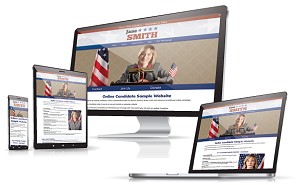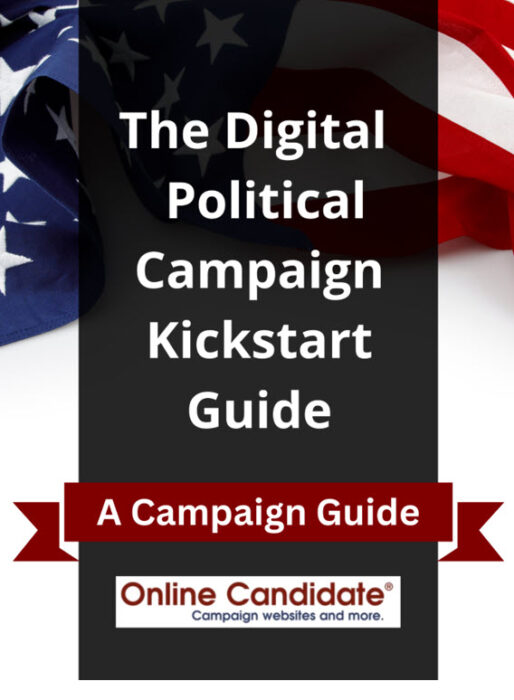Political campaigns try to reach voters wherever they are. Candidates still use traditional methods, such as door-to-door canvassing, yard signs and mailing. Today, political campaigners increasingly leverage online opportunities to promote their message to voters.
Even local campaigns use digital means for outreach. This includes social media, advertising on search engines, retargeting website visitors, email and text messaging – and even online polling. The modern political campaign lives and dies online.
But competition for users’ attention is greater than ever. Your digital ad campaign needs to stand out to be effective.
Tips to improve banner ad visibility and effectiveness
 Faces add interest. Logos are nice, but an image of a face on an online display ad draws immediate attention. Add a picture of the candidate (or opponent) to create visual interest. A strong image combined with a strong message is your best bet.
Faces add interest. Logos are nice, but an image of a face on an online display ad draws immediate attention. Add a picture of the candidate (or opponent) to create visual interest. A strong image combined with a strong message is your best bet.
Match your color schemes. One of your online advertising goals is to brand your campaign to voters. Maintain a consistent color scheme between you website, signs and print materials. A consistent look helps improve the visibility of your political ads.
Use a call to action. Include clear messaging and a direct call to action (CTA). A CTA statement can include “Vote on…” , “Learn More” or “Support Us Now”. Make a proposition or ask a question that encourages people to click your ad and find out more. Tell the user what you want them to do. Stick to one message or CTA per ad. If you have more than one message or request, then create a separate ad for it. You don’t have much room on a banner ad, so make the most of your space.
You can be a little odd. Ads that are nice and clean tend to blend in with a web page. Something should make your political ad stick out. It might be to include bold colors and large lettering. Another trick is to make your ad asymmetrical or use lines that are somewhat tilted. Anything that makes your ad stand out from the rest of the web page content will help it perform better.
 Add disclaimers. Your online political advertising (including your campaign website) should include the proper disclaimers. Those disclaimers should follow your local election laws and regulations.
Add disclaimers. Your online political advertising (including your campaign website) should include the proper disclaimers. Those disclaimers should follow your local election laws and regulations.
Create multiple sizes. Remarketing or IP marketing campaign ads appear across many websites and types of devices. Having multiple ads sizes will accommodate both the desktop and mobile audience.
Four types of digital political advertising
People who study political advertising understand that there are four major types: persuasion, information, identification and mobilization.
- About the Candidate Ads: These informational ads are used to introduce a candidate or organization to the general public. They often highlight the logo and visual aspect of the campagn.
- Political Issue Ads: These are an effective way to highlight a specific issue and persuade voters. Issue ads that are not targeted can be ineffective and can actually benefit your opponent. Targeting the ads to those who will be most responsive to the message will increase their effectiveness and reduce wasted spending.
- Endorsement Ads: One way for candidates to build trust with voters is through the use of endorsements from trusted organizations and individuals. These ads are targeted at voters that identify with or have similar interests to help establish credibility.
- Get Out The Vote Ads: Voter mobilization and turnout is a primary goal for all campaigns. Get Out The Vote ads are a great way to get your message in front of potential voters and drive them to the polls.
The most common display ad sizes (in pixels) are:
- 300×250
- 336×280
- 728×90
- 320×50
- 160×600
- 300×50
Size also applies to creative files themselves. Optimize your images for the smallest file size possible. Ad networks will not serve ad creative files that are too large or improperly formatted.
Split test your ad creatives. If your digital ad campaign is running long enough, consider A/B split testing your ad creatives. Make several versions of your initial ads and see which performs better. A different background color or adding a button can change the conversion rate of an ad.
 Target your audience. Most local political campaigns don’t have a huge budget. Advertising must be targeted to voters who are most likely to respond. Retargeting ad campaigns reach out to those who have already visited your website. Other forms of display advertising, like Pay Per Click and IP Marketing can be targeted to specific geographic locations or even individual households. The more defined you target your audience, the less waste you will have in your advertising spend.
Target your audience. Most local political campaigns don’t have a huge budget. Advertising must be targeted to voters who are most likely to respond. Retargeting ad campaigns reach out to those who have already visited your website. Other forms of display advertising, like Pay Per Click and IP Marketing can be targeted to specific geographic locations or even individual households. The more defined you target your audience, the less waste you will have in your advertising spend.
Have the right landing page. Send your visitor to the proper landing page after they click your ad. If you are seeking donations, don’t send visitors to your site’s home page. Send them to your campaign’s donation page. If you can match your landing page to the ad campaign, visitors won’t feel lost after they click. Landing pages that are relevant to the ad also tend to convert better.
Keep the look consistent across channels. The look and feel of your ads should be similar while you are simultaneously running display ads, video and offline marketing. This helps keep your messaging and branding consistent.
Great visuals improve interaction with your digital ads and increase the number of clicks.
Why are you running your ads?
The purpose of your ad campaign will help determine what your ads say and how they are designed. Online political ads tend to fall into several categories:
- General ads to increase visibility and name recognition
- Issue ads, and if you are for it or against it
- Attack ads against an opponent
- Endorsement ads to show what organization or person backs you
- Get out the vote reminders for early voting or general Election Day
Other restrictions in digital display advertising
At some point, you may need banner ads to promote your Facebook Page, for Google Display Ads, IP Targeting or for advertising on other websites. Political banner ads fall under various restrictions an the largest advertising networks.
For example, in the United States, Google has limits election ad audience targeting to the following:
- Age
- Gender
- General location (postal code level)
in the United States. Third party audience information is also banned. This applies to both Google search and display ads.
Both Google and Facebook now require more disclosure on political ads and who purchases them. Users who want to buy political ads be authorized. All political ads have a “paid for by” disclaimer. On Facebook, ads that run are stored in a political ad archive for outside access.
Though they are not clicked on nearly so much, the banner ad is still alive and an active part of digital advertising. To make things easier for our clients, we offer free banner ad templates that are easy to use for those without graphic design skills.
From political campaign websites to social media setup to online advertising services, Online Candidate can help start your digital campaign quickly and easily.
Ads shown as examples, not endorsements.
« Online Advertising Ideas For Political CampaignsChoosing a Political Campaign CMS »
Tags: campaign promotion, geotargeting







